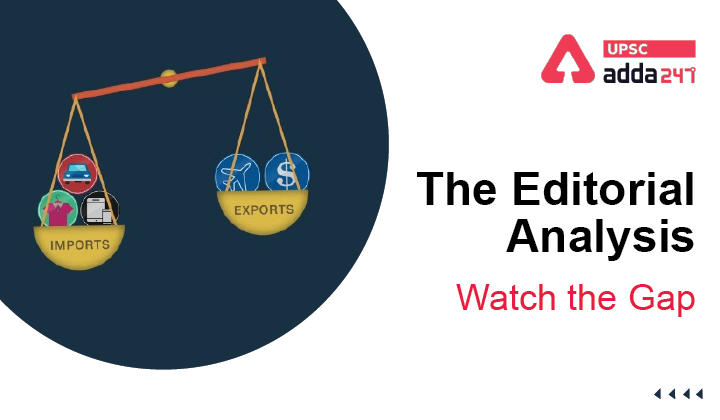Table of Contents
Watch the Gap- Relevance for UPSC Exam
- GS Paper 3: Indian Economy– Issues relating to planning, mobilization of resources, growth, development and employment.
Widening Trade Deficit in News
- Recently released Official data on India’s trade balance shows a widening of the Trade deficit, requiring immediate attention to contain it from any further rise.
Official Data on India’s Trade Balance
- Exports: Emerging from a record export performance during the just-concluded financial year, outward shipments for the month rose 24.2% from a year earlier, with electronics and chemicals showing healthy expansion, while petroleum products more than doubled.
- Imports: Imports continued to outpace exports, growing by 26.6% to broaden the goods trade deficit, which widened to $20.07 billion from $18.5 billion in March.
- Trade deficit: it worryingly breached $200 billion for a rolling 12-month period for the first time in April, impacted predominantly by petroleum imports of $172 billion.
- Trade Deficit is the extent to which the import bill exceeds export receipts.
Challenges to India’s Trade Deficit
- Russia Ukraine War: Global crude oil prices have surged by more than 40% in 2022 in the wake of Russia’s war on Ukraine, swelling the import bill.
- Rising Coal Import: The early onset of the Indian summer, with a heatwave, has bolstered power demand, setting the pace for coal imports, which grew 136% last month, notwithstanding record output by key domestic supplier Coal India.
- For the first time ever, the Ministry of Power has set timelines for States to import coal over the next few months.
- This is disturbing especially when India saw a 16% year-on-year decline in imports of the fuel in the April 2021-January 2022 period.
- Rising coal imports set a clear portent that the bill for overseas purchases of coal is also set to swell.
- Widening Current Account deficit: Disconcertingly, foreign direct investment, which typically helps bridge the CAD, has seen a moderation.
- And, the wider the CAD, the greater the downward pressure on the rupee, which has already weakened considerably since the conflict in eastern Europe began in February.
- A weaker rupee, in turn, makes imports costlier, potentially widening the trade deficit, and thus triggering a vicious cycle.
IndAus ECTA: India Australia Economic Cooperation and Trade Agreement
Way Forward
- RBI’s Role: The RBI has sought to steady the rupee against wild swings, evident in the dip in foreign exchange reserves to $600.4 billion (April 22), from $640 billion just six months earlier.
- But a central bank can draw on the reserves to ease any rupee weakening only to a limited extent.
- The RBI also has its hands full with the battle against imported inflation as global commodity prices remain sharply elevated.
- Government’s Role: To help avoid added stress, the Government must consider additional incentives for exports, while encouraging local production of items that strain the import bill.
- Better Demand Prediction: The coal crisis could have been averted with better-advanced estimates of power demand as the country emerged from the worst of the pandemic, and optimal allocation of coal-carrying rail wagons.
- Policymakers can ill afford to let their guard down on trade imbalances and risk growth-retarding inflation and more pressure on the rupee.
NITI Aayog Releases Export Preparedness Index 2021





 TSPSC Group 1 Question Paper 2024, Downl...
TSPSC Group 1 Question Paper 2024, Downl...
 TSPSC Group 1 Answer key 2024 Out, Downl...
TSPSC Group 1 Answer key 2024 Out, Downl...
 UPSC Prelims 2024 Question Paper, Downlo...
UPSC Prelims 2024 Question Paper, Downlo...




